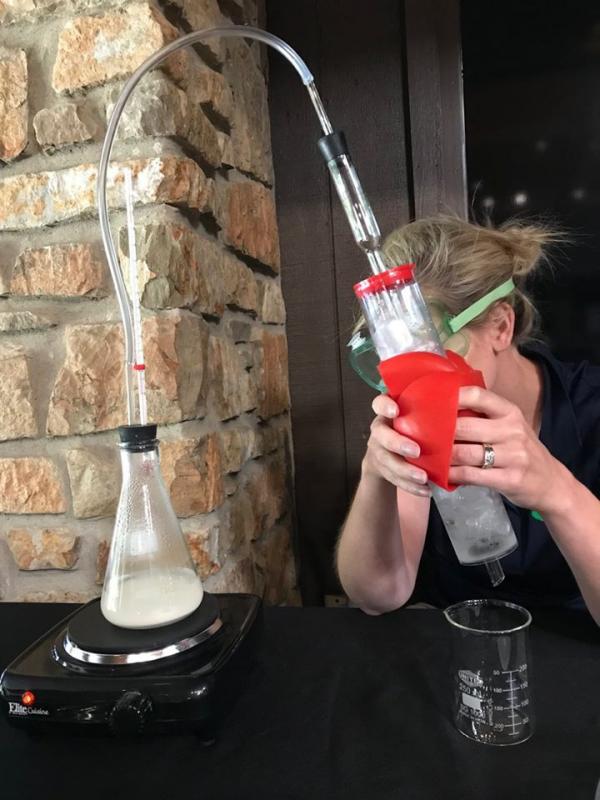MIDDLE SCHOOL
Issues in Science is a hands-on, middle school science curriculum that prioritizes hands on instruction over screen time.
Instructional design and unique equipment bring out student ideas and learning through personal, concrete experiences while issue-oriented science helps students see how science is connected to their lives and communities.
Take a look through a typical unit here.
View the OK Science | Grades 6-8 Correlations

EdReports
Issues and Science has earned the second-highest overall scores for middle school science curriculum. EdReports found Issues and Science to fully meet expectations for three-dimensional learning and assessment, to present phenomena and problems as directly as possible, and to use the assessment system to show evidence of increasing student sophistication in the content from grade six to grade eight.

Three-Dimensional
Representing 3-D learning visually
These Learning Pathways are used in unit development by SEPUP, at the Lawrence Hall of Science, in the same way schools are using multi-colored stickies to ensure the three dimensions are authentically intertwined in the activity and unit design. Starting at the bottom and moving up towards the Performance Expectation, specific unit activities are identified at the Disciplinary Core Idea, and connected to the Science and Engineering Practices, Cross-Cutting Concepts, and Common Core standards for Math and ELA. Those in rectangular boxes are the suggested connections identified in the Oklahoma Academic Standards for Science, while the ovals represent additional connections made within the SEPUP unit.
View each of the Learning Pathways for each Issues and Science units.
Problem-Based
Issues and Science, developed by SEPUP at the Lawrence Hall of Science, uses a socio-science issue at the heart of each unit that creates a storyline for students to follow. Often students are introduced to a character, a problem, or an intriguing phenomena that they all experience together, so that students can all connect to it as they start the unit.
The issues in SEPUP's Issues and Science provide context for relevant and connected anchoring and investigative phenomena within the unit

Assessment
The SEPUP Assessment System is based on the idea that students benefit from regular opportunities to demonstrate learning through performance in the context of their work at hand.
Each unit includes a variety of assessments embedded within the instruction context to provide consistent, actionable information to the teacher, and students, with minimal impact on instructional time.
WHAT ARE OTHERS SAYING ABOUT ISSUES AND SCIENCE?
GET TO KNOW LAB-AIDS HIGH SCHOOL CURRICULUM

SEPUP™ SCIENCE AND GLOBAL ISSUES: BIOLOGY
The five units in this High School Biology program look at the issues of human impact on ecosystems, world health, genetically modified organisms, and biodiversity - complex issues that have no simple solutions. In each unit students are challenged to reason scientifically while applying their understanding of the main science concepts and issues. Students gather and analyze associated evidence, review possible actions to address the issue, and develop arguments from evidence while considering the trade-offs of each decision.
Click here to see the strong alignment to the OK Biology Standards

EDC EARTH SCIENCE
EDC Earth Science is designed around the belief that students are capable of rigorous and in-depth explorations in science when given adequate support, structure, and motivation for learning. Students perform data-intensive Earth Science investigations set in real-world contexts. They also engage in a variety of other activities, including topical fiction and non-fiction readings and research projects and presentations that build critical life and scientific literacy skills.
Click here to the strong correlation to the OK High School Earth Science standards.
A NATURAL APPROACH TO CHEMISTRY
Chemistry taught as it was meant to be taught. This program puts the relevance of understanding chemistry front and center through its spiraling, integrated, and coordinated learning system. Essential chemistry content is explored through labs, activities, and readings in a context that is topical, meaningful, and accessible for high school students. Hands-on labs and activities are integrated within a more classic textbook framework as students use specially designed probeware and other unique equipment to gather, analyze, and model data.
View the strong alignment to OK Chemistry standards.
LEARN MORE ABOUT OUR AGRICULTURE PROGRAM

AGRICULTURE SCIENCE
Lab-Aids Applied Science Concept kits and modules, our CASE material packages, and SEPUP products address key agriscience and STEM content through relevant real-world issues. This approach both motivates students and enhances understanding, while preparing them for critical thinking in college, career, and life.
Contact Us
Want to see a Lab-Aids specialist get really excited? Ask to see our evidence of OAS-S design in our middle and high school programs.


